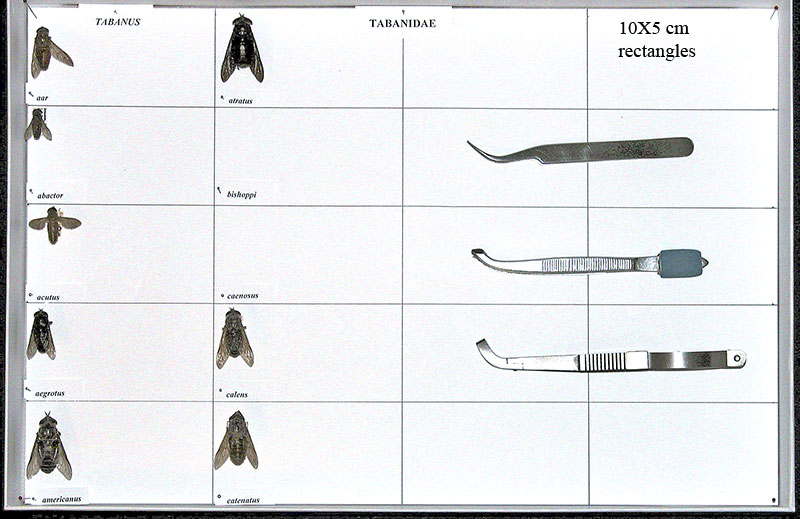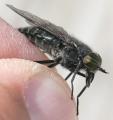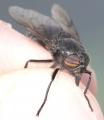Diptera.info :: Miscellaneous :: General queries
Who is here? 1 guest(s)
|
Pinning flies and wasps and some curious questions.
|
|
| Tony T |
Posted on 11-09-2007 15:37
|
|
Member Location: New Brunswick, Canada Posts: 664 Joined: 08.02.07 |
jorgemotalmeida wrote: Tony, usually how do you organize your boxes? You put many families in the same box? Or did you in this way: 1 - for your favourite families, you got ONE box specially for it, and then you organize the box in alphabetical order for genus?. 2 - for the rest, we mix all in the same box.. and just try to organize them in alphabetical order?.. or in taxonomical order, I mean, similarities among the families. 3 - or other?  Thank you. One family per storage box and the just 1 genus per box. If there are very few species in a genus you can put more than 1 genus per box. Divide the box into rectangles, size of rectangle depending on size and number of specimens. Put just 1 species per rectangle. If I was collecing smallish flies then rectangles of 10x5 cm as in the photo would be fine. If I was collecting tabanids I would divide the boxes into columns; in this example a column would be the size of 5 rectgangles. I use tabanids in this example as these are the most flies I have. I would leave empty rectangles for species I would expect to catch. I think you can see how much more efficient it would be to use unit trays, 1 tray per species. These can then be easily rearranged. This box has a plastozoate pinning bottom. I covered it with paper (paper held down in corners with pins) so that I could draw the rectangles. I would not want to draw directly onto the plastozoate. I use very fine pins and direct pin. Never had problems with labels working loose. Use entomological pinning forceps to hold the pin when pushing the pin through the labels(s) and when pushing the pin into the bottom of the box. I show 3 types, the bent ends allows you to hold the pin beneath the specimen and close to the point of the pin; this prevents the pin from bending Tony T attached the following image:  [88.25Kb] |
|
|
|
| crex |
Posted on 11-09-2007 15:44
|
|
Member Location: Sweden Posts: 1996 Joined: 22.05.06 |
Tony T - Do you collect Tabanids from other places than North America? I think you got enormous amounts of Tabanids species there, but if you do I will get you some swedish ones next summer  |
|
|
|
| Tony T |
Posted on 11-09-2007 19:06
|
|
Member Location: New Brunswick, Canada Posts: 664 Joined: 08.02.07 |
An embarrassing question. Earlier this year Nikita offered to collect tabanids for me in exchange for NA flies that he was particularly interested in. Knowing that he would be able to collect dozens, if not hundreds of tabanids, and expecting that I would catch maybe just 1 of the flies that interested him, I thought it best to tell him that I collected only NA tabanids. Not sure how he would have reacted to receiving essentially nothing in return for the considerable effort on his part. In fact, I am interested in obtaining tabanids world wide and welcome any you collect for me. The only specimens I can guarantee for exchange purposes are local Canadian tabanids. Tabanids and most flies seem to be magnets for lepidoptera scales, therefore they should be caught in a net that has never seen, or been within 1 Km., of a butterfly or moth. Same goes for collecting containers. Tabanids should be killed soon after collecting. Killing by freezing (-17C) is ideal as the wings, upon thawing, move away from the abdomen and point upwards at a 45 degree angle. Simply pin the thawed fly though the center of the thorax. Important not to lose the antennae, or legs. If Nikita reads this, my sincere apologies. |
|
|
|
| jorgemotalmeida |
Posted on 11-09-2007 19:16
|
|
Member Location: Viseu - PORTUGAL Posts: 9296 Joined: 05.06.06 |
-17 ?C??? where will we get a freezer so cold?  we must go to Antarctica... but Nikita has Siberia near.. we must go to Antarctica... but Nikita has Siberia near..  |
| Tony T |
Posted on 11-09-2007 19:39
|
|
Member Location: New Brunswick, Canada Posts: 664 Joined: 08.02.07 |
OK Jorge, where the heck do you live? you have a camera, you have a computer, and you obviously have internet access; also a friend with a laser printer. But you can't buy paper, you can't buy cardboard boxes, seem never to have heard of a freezer. Most North Americans buy fresh and frozen food, we store our frozen food in a freezer @ about -20 C; most houses have freezers and we are a cold climate! -17 C is a mild winter's day here, regularly reach -30 C and then +34 C in the summer. No need to go to Siberia for cold weather  |
|
|
|
| jorgemotalmeida |
Posted on 11-09-2007 20:06
|
|
Member Location: Viseu - PORTUGAL Posts: 9296 Joined: 05.06.06 |
 LOL LOLI was just kidding, Tony. It wasn't to take serious.  Now, serious: yes, I have a freezer with -20/-30 ?C  eheh eheh Fortunately, we have fair Winter - very rare to drop below 0 ?C. Sometimes we have very hot Summers. But this Summer was the most cold in 20 years. One thing that we haven?t it is an entomological store. 
Edited by jorgemotalmeida on 11-09-2007 20:07 |
| ChrisR |
Posted on 11-09-2007 20:50
|
|
Super Administrator Location: Reading, England Posts: 7703 Joined: 12.07.04 |
Freezing need not lead to specimens becoming damp - as I understand it, the museums seal the boxes in plastic bags before freezing. Freezing is used by the 2 largest collections in the UK (NHM & OUM) so it must work. A standardised date format on a paper label really isn't important, unless you want to invent a scanner that will read data labels  Human brains are complex enough to work out any date system as long as it conforms to one of the many standards - it's just computers that have difficulty. Of course, a standard date format such as yyyy-mm-dd hh:mm Human brains are complex enough to work out any date system as long as it conforms to one of the many standards - it's just computers that have difficulty. Of course, a standard date format such as yyyy-mm-dd hh:mm s is great for computer systems s is great for computer systems  Any nationaly recognised grid-reference system is fine - computer GIS systems are sophisticated to convert between any known standard and on the paper card the only important things are that is should be easily recognised to anyone looking at the label; provide enough accuracy to refind/map the location and doesn't take up too much space. I stopped using what they called Vapona a long time ago so I wasn't sure if it was still available - sounds like I got out at the right moment  |
| Tony T |
Posted on 11-09-2007 20:54
|
|
Member Location: New Brunswick, Canada Posts: 664 Joined: 08.02.07 |
jorgemotalmeida wrote: One thing that we haven?t it is an entomological store.  Don't bull-shit me Jorge. So where do you think my store is? I used to live in the UK and spent vacations in Almeria, southern Spain, further south than Portugal. Just a couple of hours flight from the UK. You have access, by mail, to Watkins and Doncaster in the UK. They sell everything you need and will even print labels for you. They have been in business forever, I used to buy from them in the 1950's. In NA I used to buy my stuff from California, USA, which is a damn sight further from NB than Portugal is from the UK. |
|
|
|
| Kahis |
Posted on 11-09-2007 21:43
|
|
Member Location: Helsinki, Finland Posts: 1999 Joined: 02.09.04 |
Tony T wrote: jorgemotalmeida wrote: One thing that we haven?t it is an entomological store.  Don't bull-shit me Jorge. Calm down. I think he meant to say "I do not have a local entomological store in my town", not "there is no such thing as an entomogical store". You just have to cope with some sloppy syntax every now and then.  It is somewhat unfortunate that (broken) English became the standard means of international communication. It is by no means the easiest language to master. Kahis |
| jorgemotalmeida |
Posted on 11-09-2007 21:52
|
|
Member Location: Viseu - PORTUGAL Posts: 9296 Joined: 05.06.06 |
Tony, I meant: "in my town."  Sorry if you understood other thing. That's ok. Tricky language. Sorry if you understood other thing. That's ok. Tricky language.
Edited by jorgemotalmeida on 11-09-2007 21:54 |
| crex |
Posted on 11-09-2007 22:42
|
|
Member Location: Sweden Posts: 1996 Joined: 22.05.06 |
Tony, I don't collect myself so if you get any it will be frozen, but not pinned ... I think we got posts somewhere discribing how to package and send flies in the mail. |
|
|
|
| jorgemotalmeida |
Posted on 11-09-2007 23:11
|
|
Member Location: Viseu - PORTUGAL Posts: 9296 Joined: 05.06.06 |
Crex, I wrote in search of google: "package and send flies" and it delivered --> Did you mean: package and send files  I sent for some people some specimens (in total three specimens. lol) and usually I use tight vials (i will take a photo of the vials I use - just for weekend, ok? Recall me if I forget) and put ethanol 70%. For dry specimens I also wonder how can we send the fly without damage the setas, the wings during the transport. Because I have here some nice flies to deliver and offer.  |
| Tony T |
Posted on 12-09-2007 02:16
|
|
Member Location: New Brunswick, Canada Posts: 664 Joined: 08.02.07 |
crex wrote: Tony, I don't collect myself so if you get any it will be frozen, but not pinned ... I think we got posts somewhere discribing how to package and send flies in the mail. Thanks for your kind offer, but tabanids sent from Europe to North America in any other way but as pinned specimens will be so damaged as to be useless. So thanks again, but don't waste your time. Just keep posting those superb images. |
|
|
|
| crex |
Posted on 12-09-2007 06:29
|
|
Member Location: Sweden Posts: 1996 Joined: 22.05.06 |
Tony T wrote: Thanks for your kind offer, but tabanids sent from Europe to North America in any other way but as pinned specimens will be so damaged as to be useless. So thanks again, but don't waste your time. Just keep posting those superb images. NP. Just a thought ... |
|
|
|
| crex |
Posted on 12-09-2007 06:34
|
|
Member Location: Sweden Posts: 1996 Joined: 22.05.06 |
BTW. Some day I will probably have reason to send bugs in the mail. An article (for non-collectors like me) on how to send bugs via mail would be useful. How to kill, put in alcohol or dryed, how to package etc. I guess the Dipterists Handbook consist of such info ... if a new edition would emerge. |
|
|
|
| jorgemotalmeida |
Posted on 12-09-2007 09:40
|
|
Member Location: Viseu - PORTUGAL Posts: 9296 Joined: 05.06.06 |
try to get some entomological pins... a strong box, put the foam in bottom. Put the pin (with fly already pinned) in foam. You can put glue at the base of pin to the foam. close the box tigthly. These are general indications. More later I will try to tell the rest. I'm in a hurry now.  |
| ChrisR |
Posted on 12-09-2007 09:52
|
|
Super Administrator Location: Reading, England Posts: 7703 Joined: 12.07.04 |
It's not difficult but it helps if you decided before you killed it to make it a "specimen" and not just a dead fly  It is always preferable to pin an insect just after it died, while it is soft - and in that way you don't damage anything. Using micro-pins and just pinning to a piece of foam is the easiest, as long as you also keep the collection data with the specimen or if it is big enough you can use the larger, continental (38mm) pins but this might be more difficult for the receiver to incorporate in their own collections (I know most collectors like specimens at a certain height on the pin) and potentially cause more damage. It is always preferable to pin an insect just after it died, while it is soft - and in that way you don't damage anything. Using micro-pins and just pinning to a piece of foam is the easiest, as long as you also keep the collection data with the specimen or if it is big enough you can use the larger, continental (38mm) pins but this might be more difficult for the receiver to incorporate in their own collections (I know most collectors like specimens at a certain height on the pin) and potentially cause more damage.If you put them in alcohol make sure it is a pure methylated spirit (Industrial Methylated Spirit, in UK) or Iso-Propyl Alcohol - with no colours or additives other than a bit of water. Push a small 'bung' of tissue-paper into the spirit to stop them moving much and then seal it with an air-tight stopper. I'm not sure which I prefer to receive - it depends on the collector's experience and how much time the collector has to prepare the specimens.  |
| Kahis |
Posted on 12-09-2007 10:30
|
|
Member Location: Helsinki, Finland Posts: 1999 Joined: 02.09.04 |
So many topics in one thread.... Crex, could you please ask about sending specimens in a new thread? Kahis |
| crex |
Posted on 12-09-2007 12:00
|
|
Member Location: Sweden Posts: 1996 Joined: 22.05.06 |
Kahis wrote: So many topics in one thread.... Crex, could you please ask about sending specimens in a new thread? Sorry. here we go - Sending flies via mail! |
|
|
|
| jorgemotalmeida |
Posted on 12-09-2007 19:04
|
|
Member Location: Viseu - PORTUGAL Posts: 9296 Joined: 05.06.06 |
Thanks to all for this great thread! You are the best.  -- If I had some more doubts, I will let know you, but this seems to be enough. - Chris I used always ethanol 70% inside vials with specimens and I had never problems. ethanol 95% is very aggressive for the specimen. Ah, for those who are reading this, NEVER use formaldehyde because it damages seriously the specimen.  |
| Jump to Forum: |













